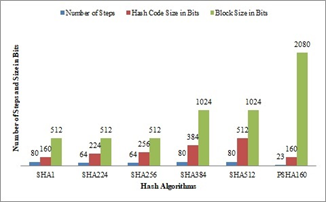Enhancing the Performance of Cryptographic Hash Function Using 2080 Bits Proposed Secure Hash Algorithm 160
DOI:
https://doi.org/10.26438/ijsrnsc.v13i1.264Keywords:
Cryptography, Hash Function, Information Security, Key ConstantAbstract
An on-way hash code or message authentication code is generated using the cryptographic hash functions. It used to be password storage, electronic data integrity, and check verification. Cryptographic hashing algorithms, which employ beginning value and key constant to boost algorithm complexity, have been proposed by a number of academics. It is well known that they have a very high temporal complexity due to the quantity of steps and memory space needed to store the beginning value and key constants. Consequently, we are improving the cryptographic hash function's performance by using 2080 bits as a block of the input message and avoiding the need for the key constant. By doing this, we are generating 160-bit fixed-length hash code, and the amount of time spent on the function proposal will be reduced in comparison to previous hash algorithms. The outcome will be compared using the amount of time in seconds that the cryptographic hash algorithms consumed during computation.
References
B. R. Ambedkar, P. K. Bharti, Akhtar Husain."Enhancing the Performance of HashFunction Using Autonomous Initial ValueProposed Secure Hash Algorithm 256", 2022IEEE 11th International Conference onCommunication Systems and NetworkTechnologies (CSNT), 2022.
B. R. Ambedkar, P. K. Bharti, Akhtar Husain."Design and Analysis of Hash Algorithm UsingAutonomous Initial Value Proposed SecureHash Algorithm64", 2021 IEEE 18th IndiaCouncil International Conference (INDICON),2021
S. Mathew and K. P. Jacob, “Performance Evaluation of Popular Hash Functions,” World Academy of Science, Engineering and Technology, pp.449–452, 2010.
X. Zheng, X. Hu, J. Zhang, J. Yang, S. Cai, and X. Xiong, “An Efficient and Low-Power Design of the SM3 Hash Algorithm for IoT,” Electronics, vol. 8, no. 9, Art. no. 9, Sep. 2019, doi: 10.3390/electronics8091033.
A. A. Yavuz and M. O. Ozmen, “Ultra Lightweight Multiple-time Digital Signature for the Internet of Things Devices,” IEEE Transactions on Services Computing, pp.1–1, 2019, doi: 10.1109/TSC.2019.2928303.
P. Santini, M. Baldi, and F. Chiaraluce, “Cryptanalysis of a One-Time Code-Based Digital Signature Scheme,” in 2019 IEEE International Symposium on Information Theory (ISIT), Jul., pp.2594–2598, 2019. doi: 10.1109/ISIT.2019.8849244.
A. Mohammed Ali and A. Kadhim Farhan, “A Novel Improvement With an Effective Expansion to Enhance the MD5 Hash Function for Verification of a Secure E-Document,” IEEE Access, vol.8, pp.80290–80304, 2020, doi: 10.1109/ACCESS.2020.2989050.
M. Samiullah et al., “An Image Encryption Scheme Based on DNA Computing and Multiple Chaotic Systems,” IEEE Access, vol. 8, pp. 25650–25663, 2020, doi: 10.1109/ACCESS.2020.2970981.
L. Singh, A. K. Singh, and P. K. Singh, “Secure data hiding techniques: a survey,” Multimed Tools Appl, vol. 79, no. 23, pp. 15901–15921, Jun. 2020, doi: 10.1007/s11042-018-6407-5.
F. E. De Guzman, B. D. Gerardo, and R. P. Medina, “Implementation of Enhanced Secure Hash Algorithm Towards a Secured Web Portal,” in 2019 IEEE 4th International Conference on Computer and Communication Systems (ICCCS), Feb., pp.189–192, 2019. doi: 10.1109/CCOMS.2019.8821763.
A. Faz Hernández, H. Fujii, D. Aranha, and J. López, “A Secure and Efficient Implementation of the Quotient Digital Signature Algorithm (qDSA)”, pp.189, 2017. doi: 10.1007/978-3-319-71501-8_10.
X. Fei, K. Li, W. Yang, and K. Li, “A secure and efficient file protecting system based on SHA3 and parallel AES,” Parallel Computing, Vol.52, pp.106–132, 2016, doi: 10.1016/j.parco.2016.01.001.
B. Madhuravani and D. S. R. Murthy, “Cryptographic hash functions: SHA family,” International Journal of Innovative Technology and Exploring Engineering (IJITEE), Vol.2, No.4, pp.326–329, 2013.
K. Ideguchi, T. Owada, and H. Yoshida, “A Study on RAM Requirements of Various SHA-3 Candidates on Low-cost 8-bit CPUs,” 260, 2009. Accessed: Nov. 23, 2021.
V. A. Melnyk and A. Y. Kit, “Basic Operations of Modern Hashing Algorithms,” COMPUTER SCIENCE, p. 4, 2013.
W. Liang, S. Xie, J. Long, K.-C. Li, D. Zhang, and K. Li, “A double PUF-based RFID identity authentication protocol in service-centric internet of things environments,” Information Sciences, Vol.503, pp.129–147, Nov. 2019, doi: 10.1016/j.ins.2019.06.047.
S. Zhu, C. Zhu, and W. Wang, “A new image encryption algorithm based on chaos and secure hash SHA-256,” Entropy, Vol.20, No.9, p.716, 2018.
L. Grassi, D. Khovratovich, C. Rechberger, A. Roy, and M. Schofnegger, “Poseidon: A New Hash Function for Zero-Knowledge Proof Systems,” presented at the 30th {USENIX} Security Symposium ({USENIX} Security 21), 2021, pp. 519–535. Accessed: Nov. 23, 2021.
A. Kuznetsov, M. Lutsenko, K. Kuznetsova, O. Martyniuk, V. Babenko, and I. Perevozova, “Statistical Testing of Blockchain Hash Algorithms,” p. 13, 2020.

Downloads
Published
How to Cite
Issue
Section
License

This work is licensed under a Creative Commons Attribution 4.0 International License.
Authors contributing to this journal agree to publish their articles under the Creative Commons Attribution 4.0 International License, allowing third parties to share their work (copy, distribute, transmit) and to adapt it, under the condition that the authors are given credit and that in the event of reuse or distribution, the terms of this license are made clear.








